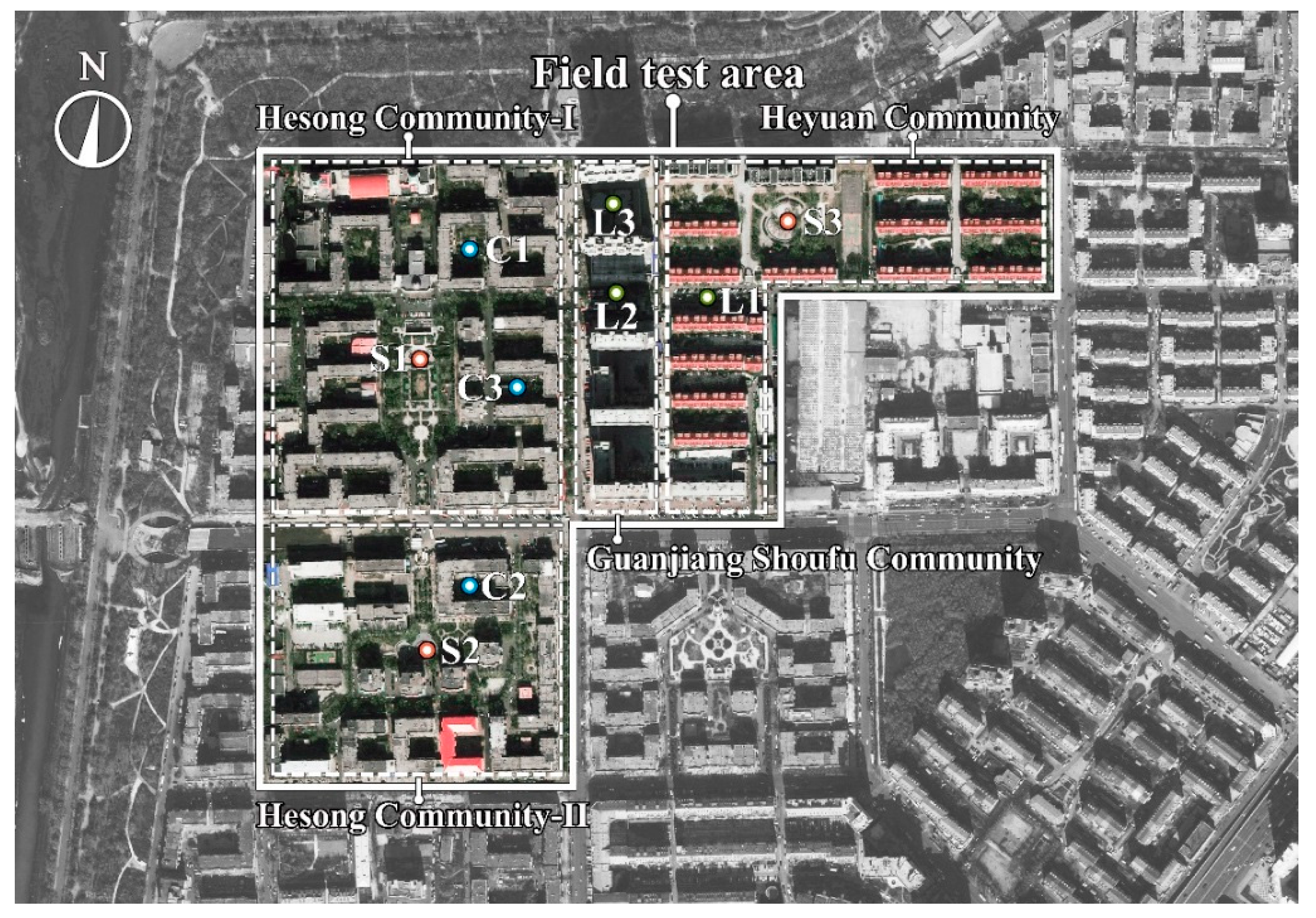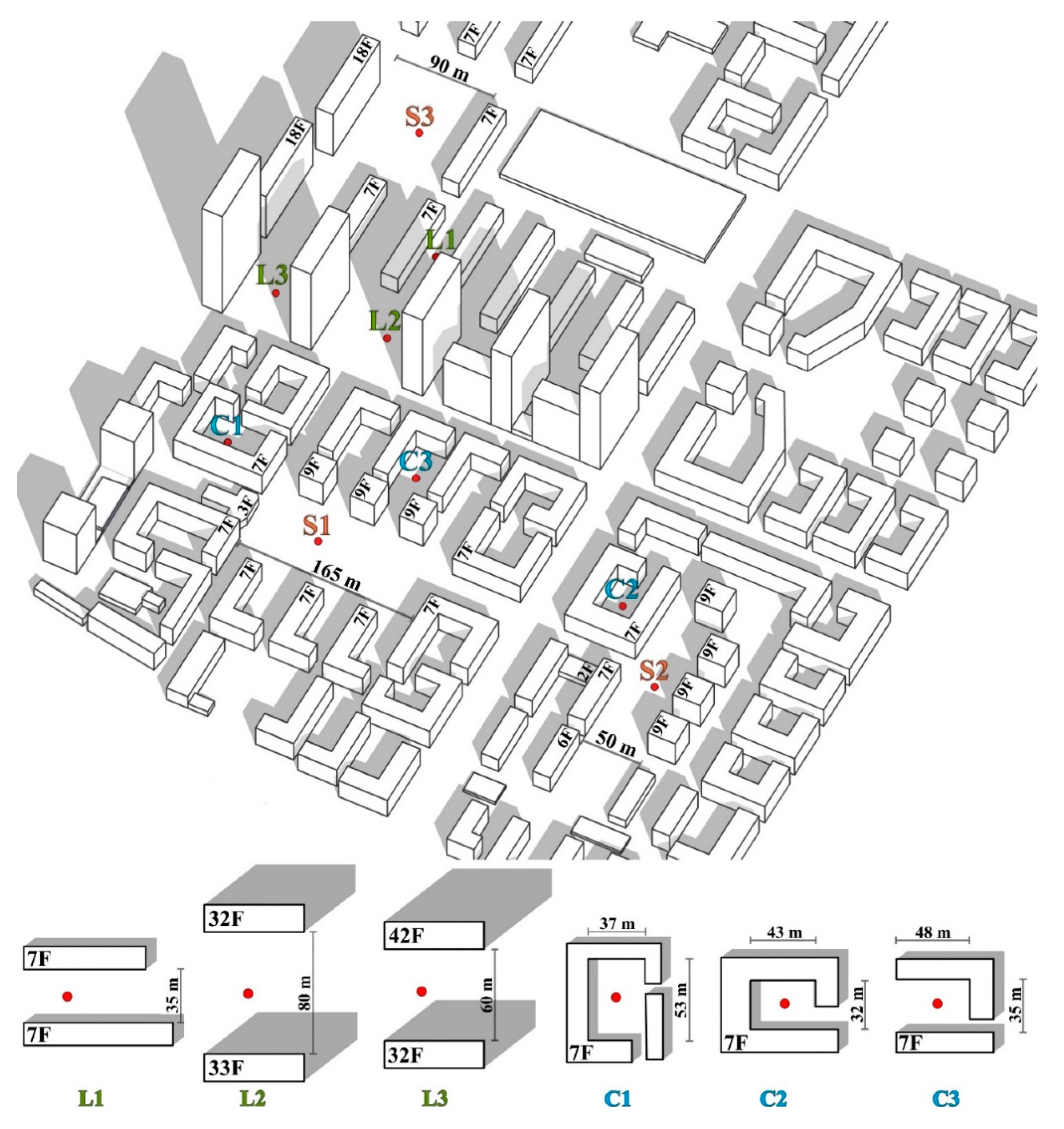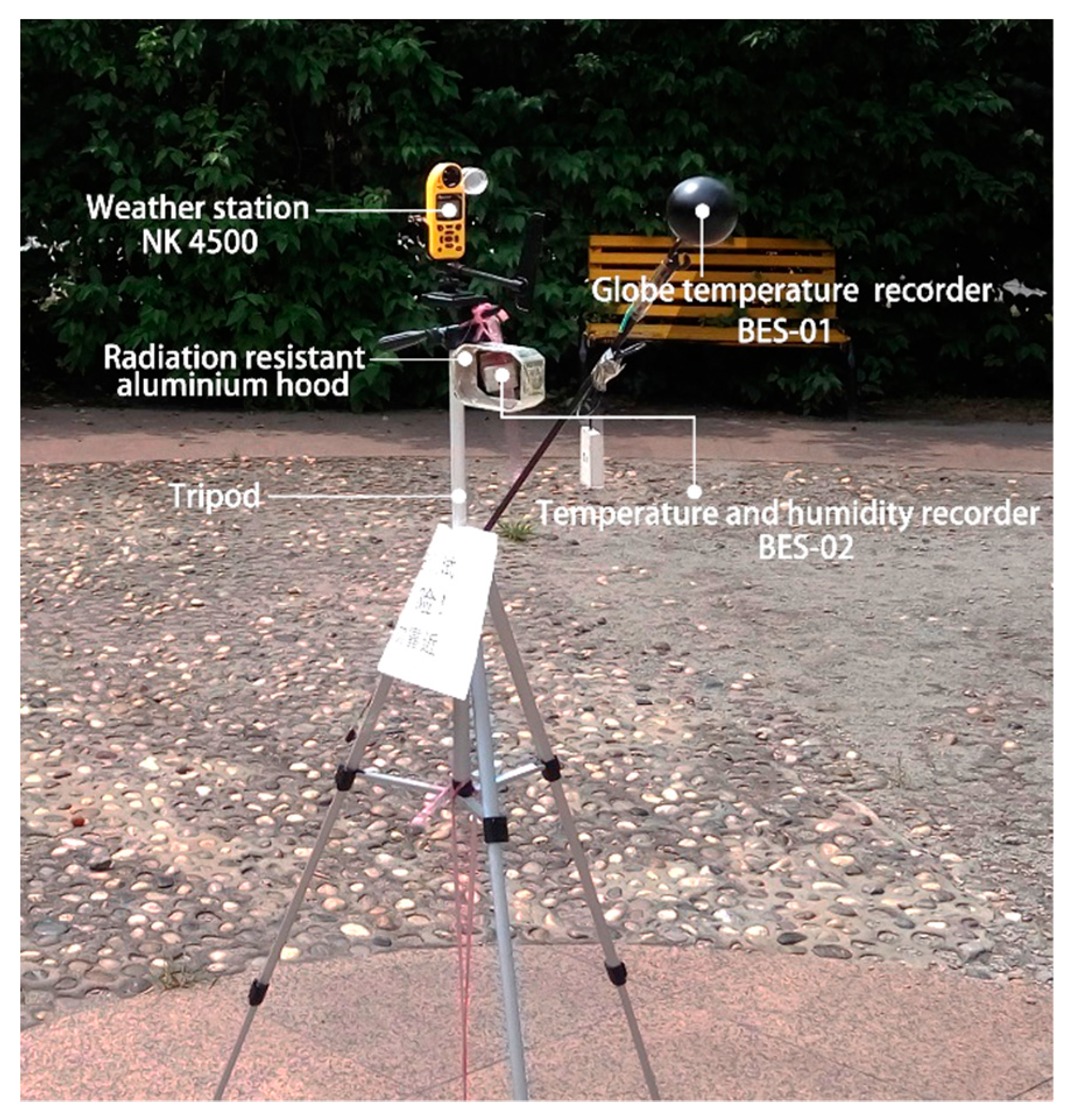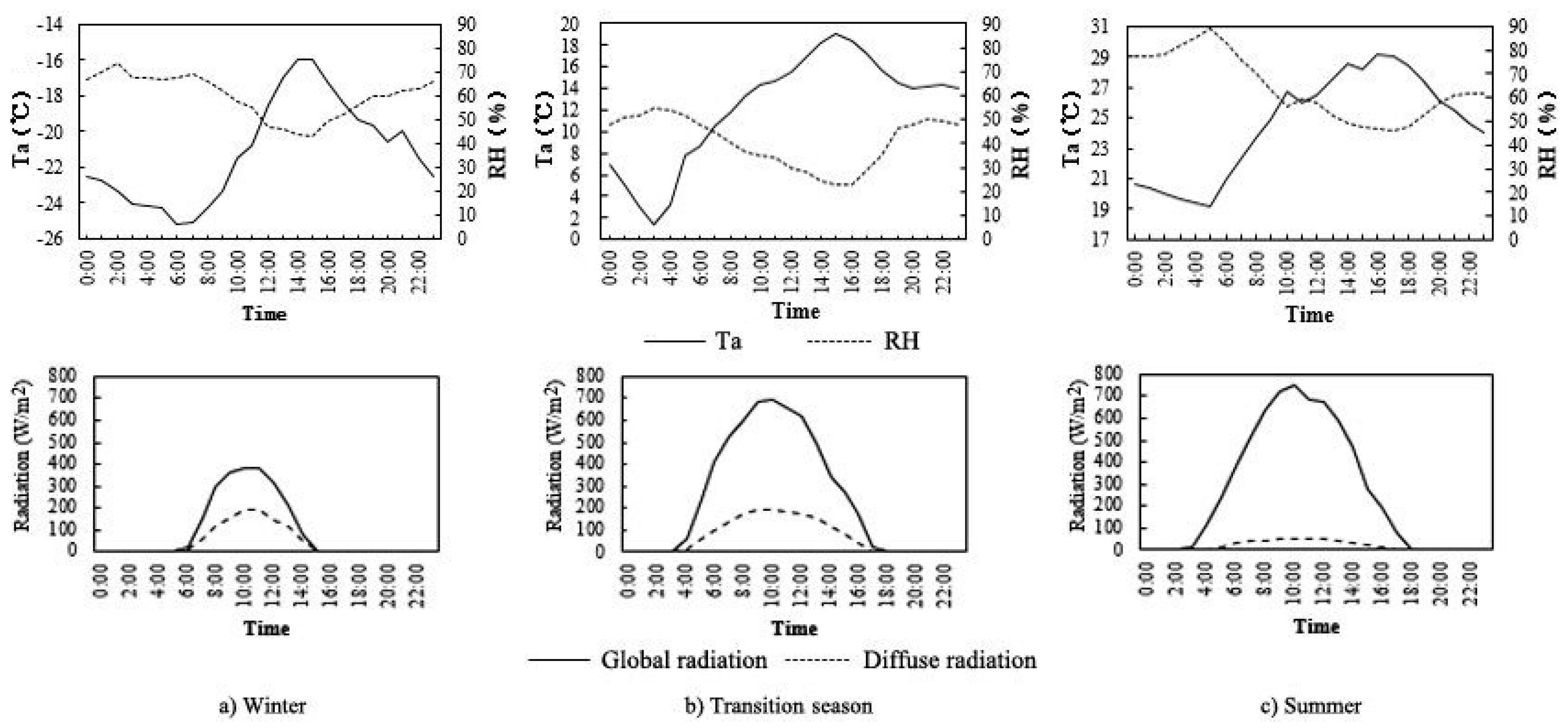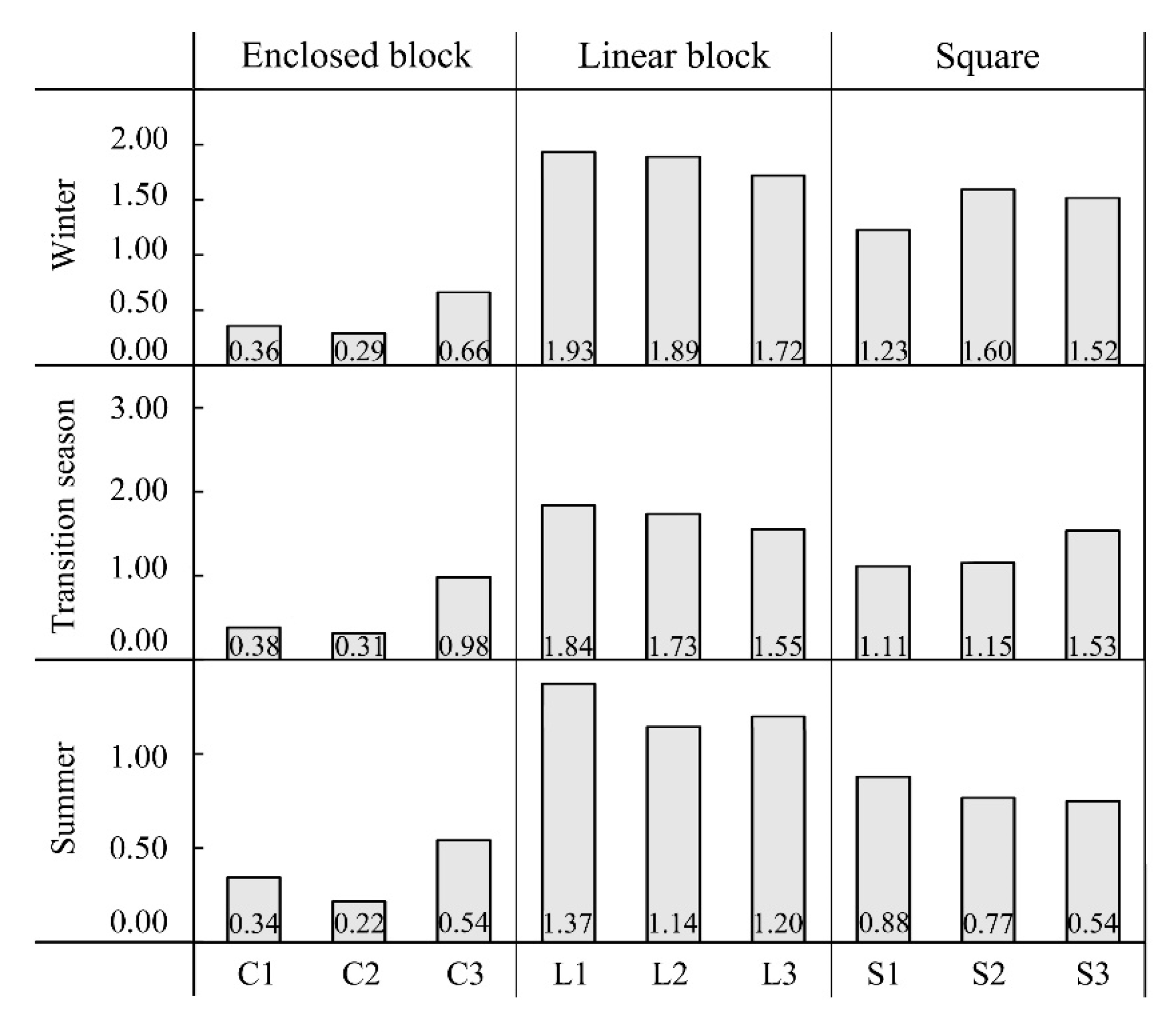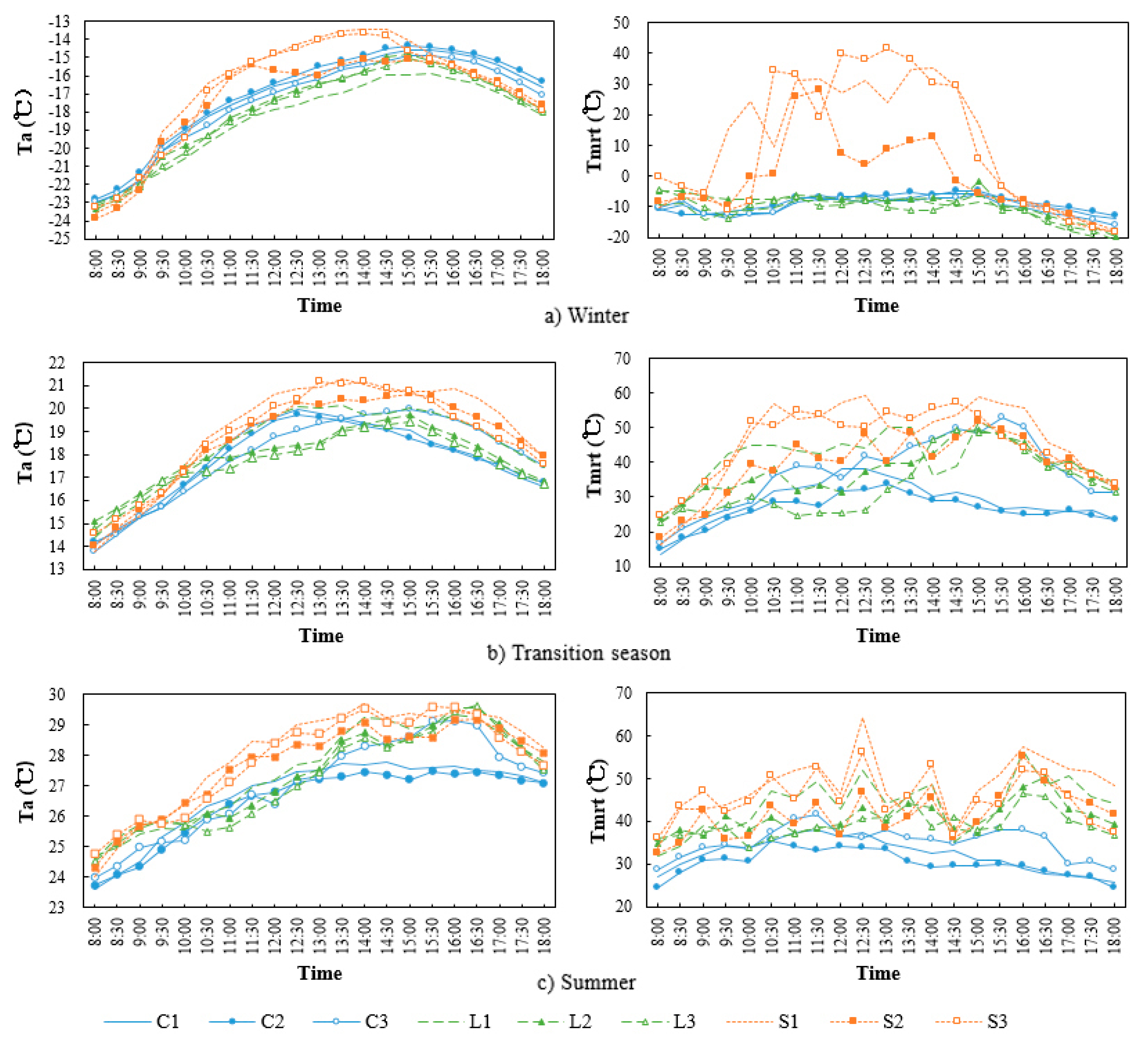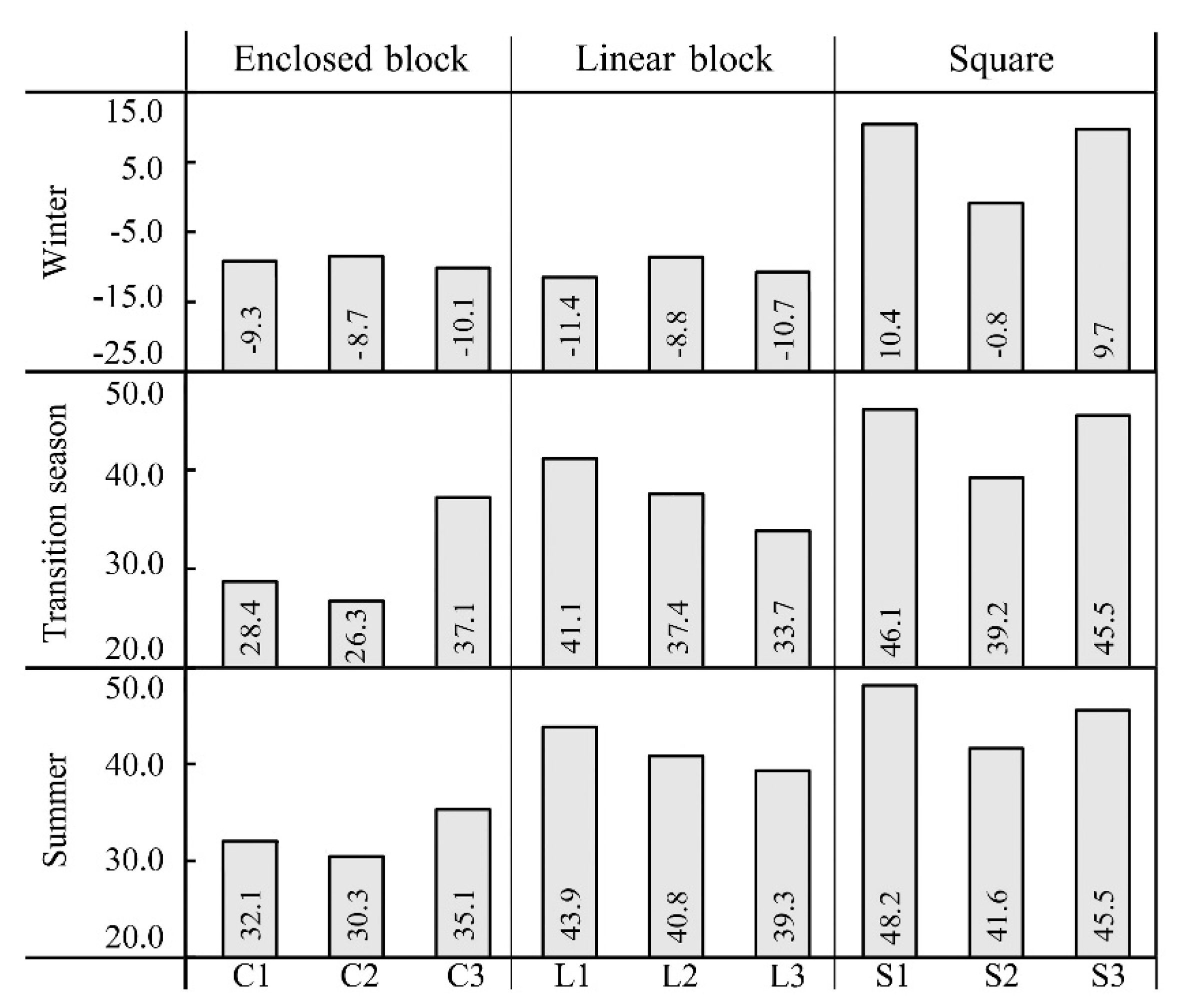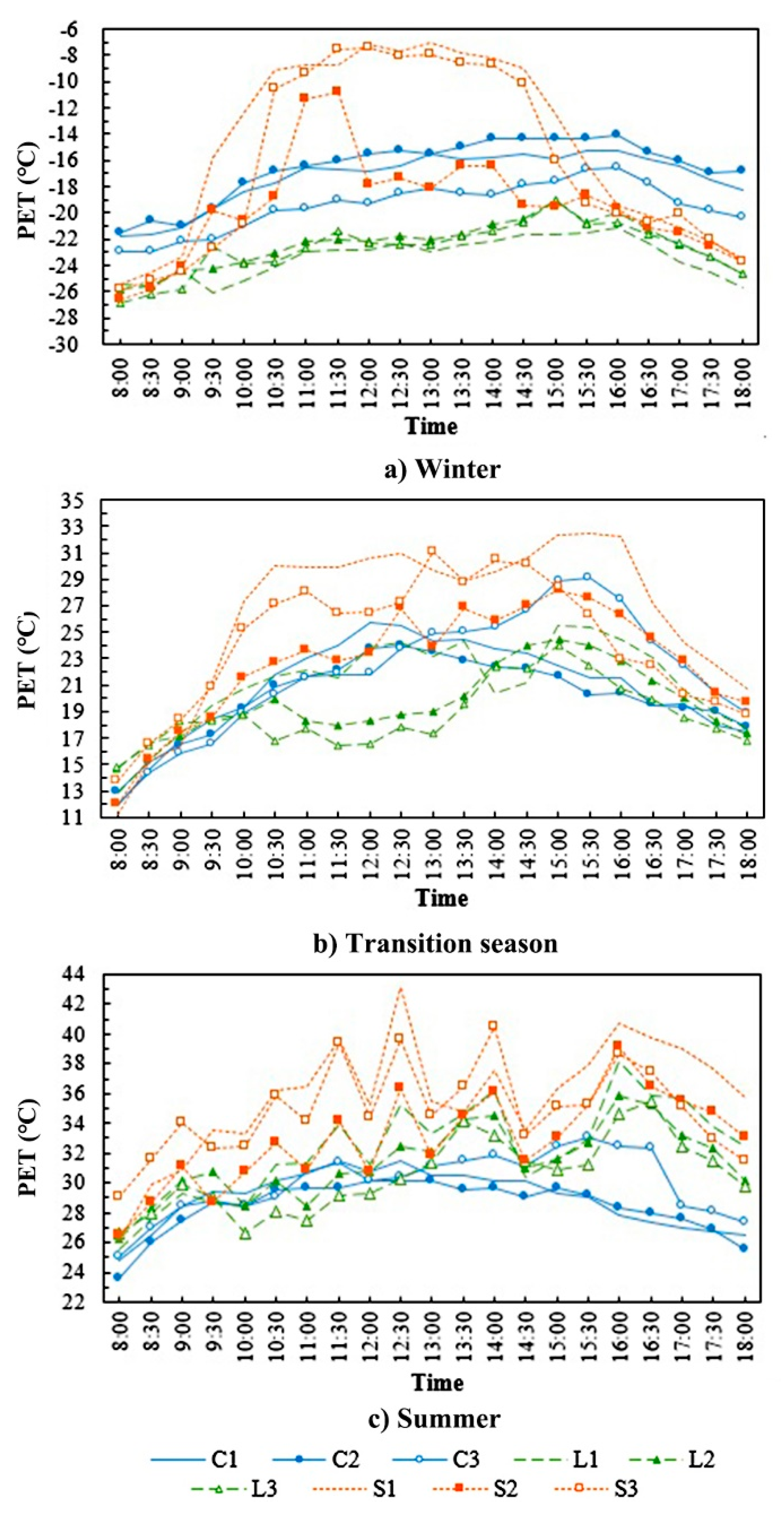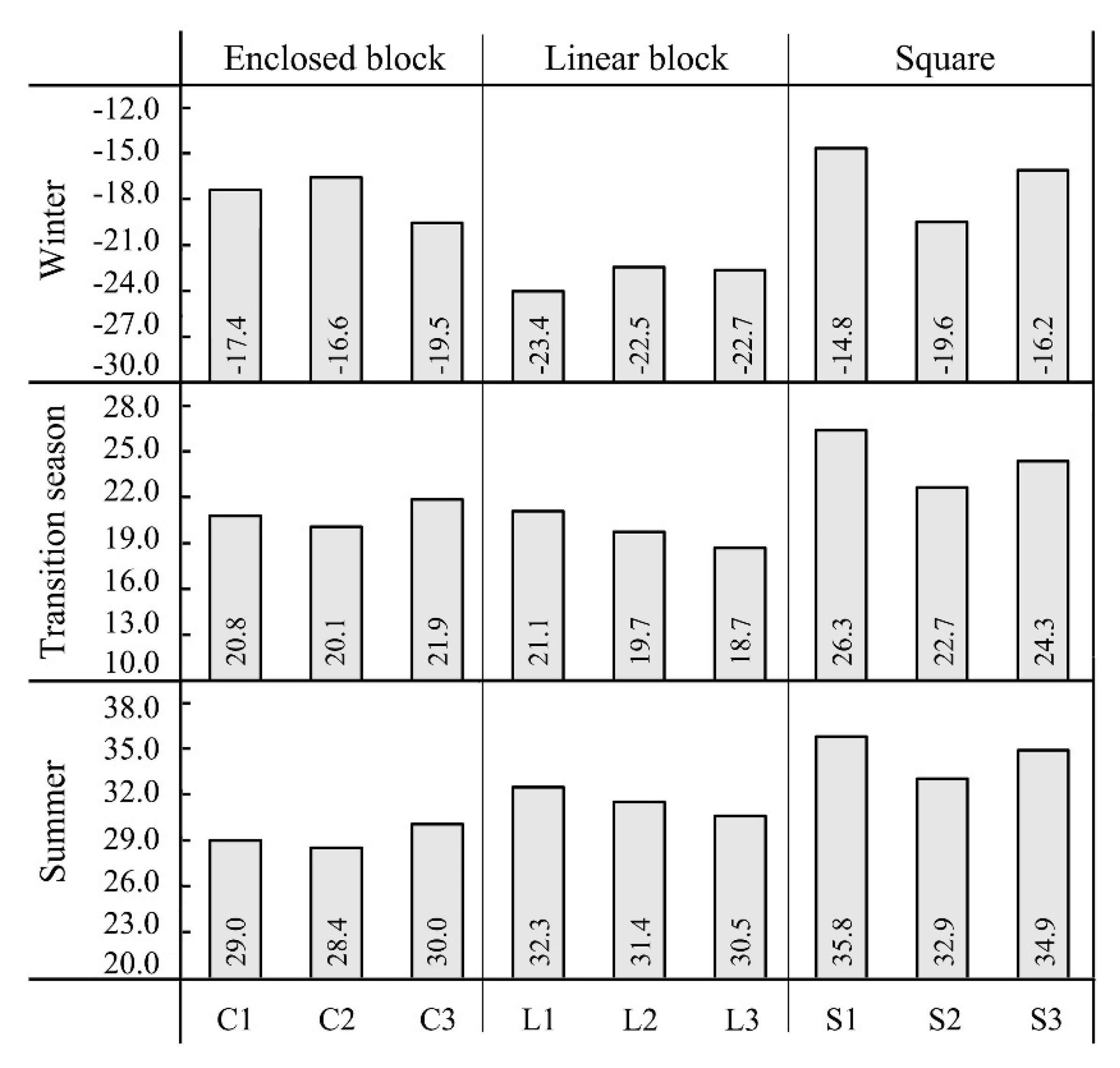1. Introduction
Global climate change is one of the major environmental problems mankind faces in the 21
st century [
1]. The World Health Organization (WHO) has estimated that climate change could cause 250,000 additional deaths per year between 2030 and 2050 [
2]. In the context of global climate change and accelerated urbanization, much attention has been paid to the issue of the urban thermal environment [
3,
4,
5]. As the basic unit of the city, the residential area is most closely related to people’s living, so its thermal environment has a direct impact on residents’ physical and mental health and their thermal comfort during outdoor activities [
6]. Therefore, in the early stage of planning, the effects of the spatial forms and configurations of the residential areas on the outdoor thermal environment should be fully considered so that a comfortable outdoor activity space and residential environment can be created [
7,
8,
9,
10].
In order to assess the outdoor thermal comfort, thermal indices, including PET [
11], Predicted Mean Vote (PMV) [
12], Universal Thermal Climate Index (UTCI) [
13], Standard effective temperature (SET*) [
14], Temperature-Humidity Index (THI) [
15,
16], Discomfort Index (DI) [
17], and Wet-Bulb Globe Temperature (WBGT) [
18], are widely used. Among them, THI, DI and WBGT are empirical indices derived from subjective comfort estimates, whereas PET, PMV, UTCI and SET* are rational indices based on the heat balance equation of the human body [
19]. PMV and SET* are typically applied for a relatively stable indoor environment, while PET and UTCI have been primarily designed for outdoor environment [
20]. Moreover, in recent studies on outdoor thermal comfort, PET is the most broadly uesd index [
21].
Currently, scholars have already widely studied the effects of different forms and configurations of urban spaces (more focus on urban canyons, courtyards, and squares) on the outdoor thermal environment and thermal comfort and the corresponding results have been acquired.
Johansson et al. [
22] made long-term observations on the thermal environment of two streets with different height to width ratios (H/W) in Morocco and analyzed the thermal comfort with PET. The results indicated that the deeper canyon was more comfortable in summer, whereas the shallower canyon was more comfortable in winter due to incoming solar radiation. Krüger et al. [
23] conducted field measurements of the microclimate in streets and squares in Brazil, created a thermal sensation equation based on the questionnaire survey and demonstrated the relationship between the SVF and the daytime thermal comfort of pedestrians. Ali-Toudert and Mayer [
24,
25] analyzed the effects of street canyon geometry on the outdoor thermal environment and thermal comfort in summer through field measurement and simulation. The results indicated that direct solar radiation had a significant effect on the thermal comfort of the human body; as the H/W ratio increases, the temperature slightly decreases. Meanwhile, when the orientation of the street tends to be parallel to the inflow wind direction, there is a reduction in the PET.
Martinelli and Matzarakis [
26] studied the effects of the H/W ratio and the SVF on thermal comfort in Italian courtyards, and the results indicated that the SVF has a great effect on the incoming solar radiation in the courtyard, which was more significant in summer. In addition, the increase of the H/W ratio can effectively improve the outdoor thermal comfort of the courtyard in winter and summer. Meir et al. [
27] conducted field measurements of the air temperature in two semi-enclosed courtyards with different orientations in Israel and the results indicated that overheat occurred during daytime in summer in the courtyards, regardless of their orientation. However, if the orientation of the courtyard is fully considered based on the solar angle and wind direction, the thermal environment of the space can be improved. Nasrollahi et al. [
28] simulated the thermal performance of traditionally designed courtyards with different orientations and H/W ratios in Shiraz, Iran. They showed that the traditional courtyard with a high H/W ratio and southward orientation could obtain better shading in summer as well as allowing the sun’s rays in while regulating the wind speed in winter. Jin et al. [
29] studied the microclimate of Chinese–Baroque historic conservation areas in Harbin, China through field measurements and simulation. They showed that the rectangular courtyard had better windbreak performance compared with the T-shaped and L-shaped courtyard; the squares had a good performance in cold resistance, and the higher the degree of enclosure of the square, the lower the internal wind speed.
Taleghani et al. [
30] studied the effects of three main urban forms (singular form, linear form and courtyard form) on outdoor thermal comfort in Holland by simulation, and the results indicated that the courtyard form had higher thermal comfort conditions, whereas the singular form had the lowest one due to the long exposure to direct solar radiation. Thorsson et al. [
31] in a simulation study of the effects of urban geometry on outdoor thermal environment in Gothenburg, Sweden found out that the squares were warmer than narrow street canyons in summer, but cooler in winter. They also showed that the densely built structure mitigated extreme swings in mean radiation temperature and PET, improving outdoor comfort both in summer and in winter. Yezioro et al. [
32] studied the effects of the length to width ratio (L/W), the height of buildings around and the orientation on solar radiation and the results indicated that for regions of latitudes 26–34°, the best orientations for squares were N–S, NW–SE, and NE–SW, and solar radiation can be increased by improving the L/W in those orientations, but the buildings around should not be taller than half the width of the square. Lin et al. [
33] conducted field measurements of the microclimate of streets and courtyards in Harbin, China. They showed that the temperature of the Northeast-Southwest oriented street was higher than that of the Northwest-Southeast oriented street in winter and summer; the courtyards with higher SVF had higher temperatures in summer and had higher wind speeds in winter and summer.
Currently, the effects of forms and configurations of urban spaces under the conditions of the hot dry climate and the hot humid climate on the outdoor thermal environment and thermal comfort have been extensively studied, whereas relatively few studies have been conducted on severe cold regions, with a lack of comprehensive consideration of the outdoor thermal environment in different seasons. This study aimed to explore the effects of forms and configurations of outdoor spaces in residential areas on the thermal environment and the thermal comfort in severe cold regions of China. Through field measurements in three seasons (summer, the transition season and winter), the study analyzed the effects of forms and configurations of three typical outdoor spaces (the linear block, the enclosed block, and the square) on air temperature (Ta), mean radiation temperature (Tmrt) and wind speed (Va). The assessment of thermal comfort was based on PET, calculated using the RayMan software. As the SVF were in inverse proportion to the H/W ratio in the linear block and enclosed block, the SVF, building spacing, building height, etc., were selected as the parameters of configurations to study the effects on the thermal environment. This study provides a reference and evaluation basis for the layout planning of residential areas of severe cold regions.
4. Conclusions
Through field measurements, this study reveals the effects of forms and configurations of three typical outdoor spaces (the linear block, the enclosed block, and the square) on the thermal environments and thermal comfort conditions at the pedestrian level in three seasons (summer, the transition season and winter) in severe cold regions in China. The conclusions are as follows:
In different seasons, the average value and the fluctuation range of Va in the linear block, the square and the enclose block decreased in order. Besides, in different seasons, the average values and the fluctuation ranges of Tmrt and Ta in the square and were all the largest. In summer and the transition season, the average Tmrt and Ta in the linear block were larger than in the enclosed block and the fluctuation range of the Tmrt in the linear block was relatively larger. In winter, the average Tmrt and Ta in the enclosed block were slightly higher than in the linear block and the fluctuation ranges of the two were both mild.
Tmrt and Ta are the main factors that affect the outdoor thermal comfort condition of residential areas in severe cold regions. In summer, the Tmrt and Ta of the enclosed block, the linear block and the square increased in order, while the outdoor thermal comfort of those decreased in order. In the transition season, the Tmrt and Ta of the square, the linear block and the enclosed block decreased in order, but the Va of the enclosed block was significantly lower than that of the linear block, so the PET of the square, the enclosed block and the linear block decreased in order. In winter, the Tmrt and Ta of the linear block were lower, and Va of that was higher compared with the other forms, so the outdoor thermal comfort of the linear block was the worst. Besides, the outdoor thermal comfort of the square and the enclosed block was greatly affected by the space configurations. In addition, the thermal environment in different space forms was relatively comfortable in the transition season, but was uncomfortable in winter and summer.
For the square, the Tmrt and Ta increased with the increase of south–north spacing and the decrease of building height on the south side, while the PET had the same trend. And the phenomenon was more significant in winter. For the linear block, in summer the Tmrt and Ta decreased as the SVF decreased, while the thermal comfort conditions were improved; in winter the Tmrt and Ta increased as the spacing between buildings increased, while the thermal comfort conditions were improved. However, in comparison with summer, the effects of different configurations of the linear block on the thermal comfort were not significant. For the enclosed block, the Tmrt and Ta in the semi-enclosed block were higher than in the full-enclosed block, and the temperature of the full-enclosed block was directly proportional to the SVF value in summer, whereas the relationships of them were opposite in winter. Moreover, the thermal comfort conditions of the full-enclosed block were better than those of the semi-enclosed block, and the thermal comfort conditions of the full-enclosed block were improved as the SVF value decreased in both winter and summer.
Currently, due to climate change and accelerated urbanization, not only the cold climate but also the hot climate in severe cold regions should be considered during residential areas planning. Therefore, the enclosed block is recommended because of providing a relatively comfortable microclimate in both winter and summer. Furthermore, the enclosed block should adopt the form of the full-enclosed, and on the premise of meeting the requirements of use, the SVF of the space should be reduced to improve outdoor thermal comfort. Besides, for squares, wide south–north spacing and low buildings on the south side should be adopted to improve the thermal comfort in winter, and deciduous trees can be planted on the south of the squares to reduce direct solar radiation, thus improving the thermal comfort in summer [
54]. For the linear block, it is appropriate to set up high-rise residential buildings and widen the south–north spacing of buildings to a certain extent.
A limitation of this study is the examination of a specific orientation. The orientation of space forms has an important influence on outdoor thermal environment, especially on the T
mrt and V
a [
25,
55]. Therefore, the effects of different orientations on outdoor thermal comfort should be studied in future research. Besides, another parameter that plays an important role in the outdoor thermal comfort of residential areas is the green plant, and the green space planning needs to be based on the outdoor space form [
56,
57]. Our recommendation for future research on the residential areas of severe cold regions is to study the influences of different layout patterns of building and green plants on outdoor thermal comfort. In addition, more field measurements and numerical studies of different locations are needed to improve the reliability and universality of research results.
